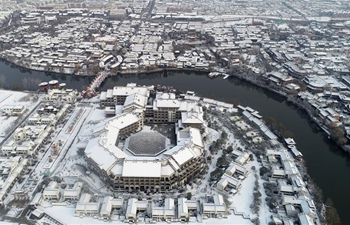LOS ANGELES, Jan. 31 (Xinhua) -- Researchers have used non-science engineering data from NASA's Curiosity rover to find Mars rocks less compacted, more porous than expected, according to a release of Arizona State University (ASU) on Thursday.
A team of researchers, including an ASU graduate student, measured the density of rock layers in the 154-km-wide Gale Crater on Mars. The findings will be published on Feb. 1 in the journal Science.
The discovery gives scientists a novel technique to use in the future as the rover continues its trek across the crater and up Mount Sharp, a 4.8-km-high mountain in its center, according to the release.
"What we were able to do is measure the bulk density of the material in Gale Crater," said Travis Gabriel, a graduate student in ASU's School of Earth and Space Exploration. He worked on computing what the grain density should be for the rocks and ancient lakebed sediments the rover has been driving over.
"Working from the rocks' mineral abundances as determined by the Chemistry and Mineralogy instrument, we estimated a grain density of 2,810 kilograms per cubic meter," he said. "However, the bulk density that came out of our study is a lot less, 1,680 kilograms per cubic meter."
The much lower figure shows that the rocks have a reduced density most likely resulting from the rocks being more porous, according to the research.
Planetary scientists have long debated the origin of Mount Sharp. The new findings suggest Mount Sharp's lower layers have been compacted by only one to two km of material, much less than if the crater had been completely filled.
"There are still many questions about how Mount Sharp developed, but this paper adds an important piece to the puzzle," said Ashwin Vasavada, Curiosity's project scientist at NASA's Jet Propulsion Laboratory in Pasadena, California, which manages the mission.
Curiosity landed near Mount Sharp in the Gale Crater on Mars in August 2012, and reached the base of the mountain in 2014.



















